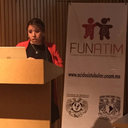Clinical and biochemical findings in Mexican patients with distal renal tubular acidosis.
Ключови думи
Резюме
BACKGROUND
Renal tubular acidosis (RTA) is a rare disease characterized by a normal serum anion gap, sustained metabolic acidosis, low concentration of plasma bicarbonate, variable hyperchloremia and hypokalemia and conserved glomerular filtration rate. RTA is developed during the first year of life and produces failure to thrive and anorexia. Primary distal RTA (type 1) is a renal syndrome with a reduced ability to excrete the acid load through the collecting ducts and impairment to concentrate the urine causing polyuria and dehydration.
OBJECTIVE
Evaluate the current health status and describe the clinical findings and progress of Mexican patients with distal RTA. Demonstrate the distal urinary acidification defect by measuring the urinary pCO2 tension in alkaline urines.
METHODS
We looked for infants in tertiary care hospitals with a clinical history of normal serum anion gap, metabolic acidosis, hypokalemia, hyperchloremia, nephrocalcinosis, sensorineural hearing loss and inability for urine acidification under systemic metabolic acidosis. Biochemical analysis were performed periodically. Alkali medication was not suspended in one patient to assess urinary acidification with oral administration of sodium bicarbonate (2 mEq/Kg) and acetazolamide (500 mg/1.73 m2 body surface). Urinary pCO2 levels were determined at 60 and 90 min.
RESULTS
Three children, one adolescent and one adult with distal RTA were found. They had an infant history of dehydration, failure to thrive, anorexia, vomiting, muscle paralysis, hypercalciuria, urinary infections, polyuria, polydipsia and polyhidramnios during pregnancy. Severe nephrocalcinosis was detected in all patients whereas sensorineural hearing loss was developed in four cases. Under the alkali medication all cases but one were normocalciuric. A patient developed kidney failure. The urinary acidification test confirmed the innability to eliminate the acid load.
CONCLUSIONS
Early diagnosis in infancy and continuos alkali medication were of great benefit for most of the patients. Urinary pCO2 levels in alkaline urine provided an index for collecting duct hydrogen-ion secretion. To our knowledge this is the first report of mexican patients with distal RTA.



